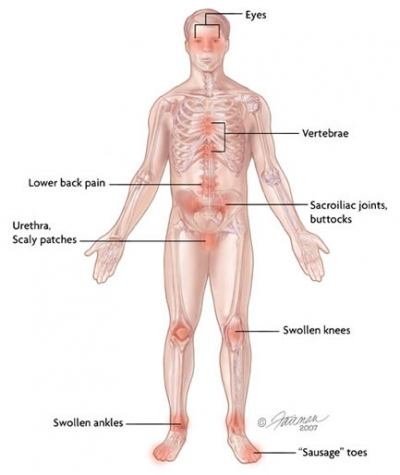Reiter's syndrome: it all starts with an infection
Reiter's syndrome is a chronic inflammatory disease. It occurs periodically and affects not only the joints (it usually starts in the knees, feet or ankles), but also other parts of the body, especially the urethra and the eyes. When it affects the eyes it can lead to conjunctivitis, the inflammation of the conjunctiva. The syndrome most commonly affects men between 20 and 40, among whom it develops after an infection with a sexually transmitted disease, but it can also occur in individuals with genetic predispositions connected with the HLA-B27 gene.
Reiter's syndrome is also called reactive arthritis because it seems that the inflammation of the joint is a reaction to an inflammation of some other part of the body, rather than the joint.
Causes and symptoms
This disease is caused by an unusual reaction of the body to infections (be it a sexually transmitted disease, or a digestive tract infection). Symptoms include urethritis, conjunctivitis and pain in the joints – usually the knees and toes, as well as areas where the tendons connect to the bones, such as the heels.
New research shows that rheumatoid arthritis and other rheumatic diseases in chimpanzees, rats, swine, poultry and other domestic animals are often caused by microorganisms. Two of these culprits are mycoplasma and chlamydia – a parasitic bacterium which causes Reiter's syndrome in the connective tissue, among people with genetic predispositions.
The combination of symptoms in the joints, genitalia, urinary organs, skin and eyes can lead the doctor to suspect Reiter's syndrome. Since these symptoms don't necessarily appear simultaneously, the disease can remain undiagnosed for as much as several months. There are no simple laboratory tests that can confirm the diagnosis.
What can be done?
Generally, antibiotics are used to treat the infection and non-steroidal anti-rheumatics can reduce the pain and joint inflammation to the lowest possible level. Although patients usually recover, symptoms of arthritis can appear and disappear through a great number of years.
Source: Excerpt from the book "Living with arthritis"
Image source; © 2013 American College of Rheumatology







